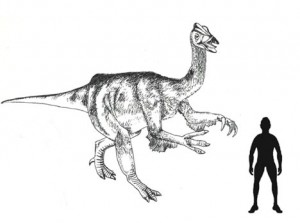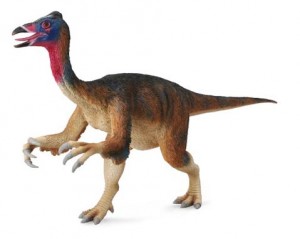Deinocheirus mirificus – Very ” Peculiar Terrible Hand”
Yesterday, a team of international scientists published a scientific paper on the bizarre dinosaur called Deinocheirus. Everything Dinosaur team members had published data on this prehistoric animal and reported on the research almost a year ago, when it was discussed at the Society of Vertebrate Palaeontology conference. Anyway, it is important for teachers to note that the science of palaeontology is ever changing. New fossil discoveries and new techniques used to study previously well-described fossil material are providing lots of new insights into the Dinosauria.
An Illustration of Deinocheirus
Picture credit: Everything Dinosaur
Deinocheirus
The first fossils of this dinosaur consisting of a huge pair of arms over 2.4 metres on length were discovered by a joint Mongolia/Polish expedition to the exposed Nemegt Formation in the Gobi Desert. This expedition was led by a remarkable woman, Professor Zofia Kielan-Jaworowska. An announcement about the fossil discovery was made a year later and in 1970 a new genus and species of dinosaur was erected based on a study of the fossilised arm bones and a few other fragmentary pieces of bone that had been found at the same location.
This dinosaur was named Deinocheirus mirificus, the name translates from the Greek to mean “peculiar, terrible hand”. Just how peculiar, scientists have had to wait the best part of fifty years to find out.
To read more about the research about Deinocheirus, believed to be one of the largest omnivores that ever lived: Deinocheirus 2014 Research.
Changing Perceptions
One of the important things to note about Earth sciences such as palaeontology which has connotations in how the theory of evolution is explained and interpreted, is that new fossil finds and discoveries can alter views and perceptions. For example, the much more complete fossils found of Deinocheirus which helped scientists piece together a much more detailed description of this dinosaur have raised a number of questions about this Late Cretaceous prehistoric animal.
It had a pygostyle (fused tail vertebrae), like a bird. It is the only dinosaur in the ornithomimid (bird mimic) family that had a pygostyle as far as we know. Finding this anatomical feature on this huge dinosaur, has led palaeontologists to review other ornithomimid fossils to see if closely related dinosaurs in this family may have possessed fused tail vertebrae.
A Model of Deinocheirus (CollectA Deluxe)
To view the CollectA Deluxe Deinocheirus dinosaur model and the rest of the CollectA Deluxe range of prehistoric animal models: CollectA Deluxe Prehistoric Life Figures.



